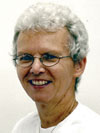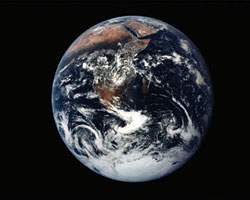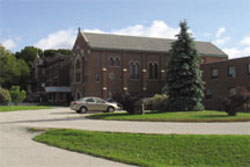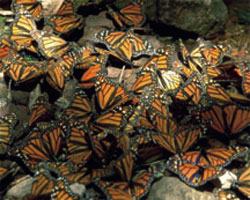
Greening sacred spaces
Helping people take action to make their home, workplace and place of worship environmentally friendly
By Louise Malnachuk
March/April 2008
Return to Table of Contents
Print Article
Climate change is a hot topic these days but the truth of the matter is that all environmental issues are in need of our urgent attention. Whether or not you agree with that premise will depend on your view of the Earth, our home.
From what I can see, we seem to live in a throwaway culture in an increasingly throwaway world. "Disposable" is the key to marketing success. Whatever is easy or instant attracts our attention. We consume the Earth's resources to produce these throwaways and the tons of garbage we generate each day go begging for disposal. We treat the planet as if it were a non-living entity, ready and willing to give of everything it has for our needs and wants.
But there is another way of looking at the Earth, one that is a product of the space age. I am referring to that famous NASA photograph taken in 1972 by Apollo 17 astronauts that shows planet Earth suspended in space. While the photo itself touches us deeply, it is the words of several astronauts in describing their view from outer space that gives us a new perspective.

Using language that is both poetic and mystical they speak as though the Earth has come alive in their eyes:
"Suddenly, from behind the rim of the Moon, in long, slow-motion moments of immense majesty, there emerges a sparkling blue and white jewel, a light, delicate sky-blue sphere laced with slowly swirling veils of white, rising gradually like a small pearl in a thick sea of black mystery. It takes more than a moment to fully realize this is Earth...home." (Edgar Mitchell, Apollo 14)
"We came all this way to explore the moon and the most important thing is that we discovered the Earth." (Bill Anders, Apollo 8)
Today, more and more people are beginning to view the Earth with new eyes, as the astronauts did. We know of the planet's magnificent capacity to renew itself from its own natural resources; that its delicately balanced ecosystems nourish and sustain all life as we know it. This awareness must lead us to act differently.
What God has begun we are called to care for, to live in harmony with, and to respect. We can start by challenging disrespectful attitudes and destructive practices towards the Earth being carried out in the name of progress. We can promote justice, unity and peace. We can make lifestyle changes, recycling more and being less wasteful. An Internet search will uncover a wealth of ideas and resources to help and guide us.
Scarboro's Mission Statement contains the following phrase: "We recognize, affirm and celebrate the sacred gift of God's creation, entrusted to all people." This belief led Scarboro Missions to take part in the city of Toronto's pilot project on the recycling of tins, glass and paper in the early 1980s. This same motivation has resulted in our taking part in another pilot project called Greening Sacred Spaces.

Developed by Faith & the Common Good (www.faith-commongood.net), Greening Sacred Spaces raises awareness about ecological issues from a faith perspective and helps people take action to make their home, work place and place of worship environmentally friendly.
Faith & the Common Good (FCG) is an interfaith network of religious communities who understand the Earth as a sacred gift. FCG believes that our faith traditions are a key source of wisdom in the great spiritual quest of our time: healing our beloved Earth. The Greening Sacred Spaces project offers a guide for people to live out the call to protect our planet home from within their own religious tradition. It involves a number of small steps, beginning with an energy audit to identify sources of energy wastefulness and then implementing the suggestions identified by the audit. These could include insulating attics and walls, weather stripping leaky doors and windows, insulating roofs, and upgrading old furnaces and water heaters.
As well as the energy audit, Scarboro Missions also benefited from a grant from Greening Sacred Spaces in return for participating in another pilot project with respect to electrical consumption. This was a program of awareness that included installing energy efficient lights throughout the building.
These small steps are our way of recognizing and affirming the sacred gift of God's creation. They are our way of preserving the Earth as "Holy Ground". They are part of our conscious effort to walk softly on this living planet.
Scarboro missioner Louise Malnachuk is a member of Scarboro's house coordination team.
Unless we change
"...we must, first of all, really understand that unsustainability means CANNOT AND WILL NOT SURVIVE AS IS. In other words, we have no choice but to change the way we live as a human species. You will either be a contributing part of our change for the better, or, if you choose to ignore or deny the fact of our present unsustainability, you will, by default, contribute to the rapid decline of our civilization and all humanity...

...the present is really an unprecedented time of opportunity. Think of it as a stage between caterpillar and butterfly – a time of metamorphosis when an old unsustainable system fights to preserve itself as a new system struggles to be born.
Caterpillars chew their way through ecosystems leaving a path of destruction as they get fatter and fatter. When they finally fall asleep and a chrysalis forms around them, tiny new imaginal cells, as biologists call them, begin to take form within their bodies. The caterpillar's immune system fights these new cells as though they were foreign intruders, and only when the cells crop up in greater numbers and link themselves together are they strong enough to survive. Then the caterpillar's immune system fails and its body dissolves into a nutritive soup which the new cells recycle into their developing butterfly.
The caterpillar is a necessary stage but becomes unsustainable once its job is done. There is no point in being angry with it and there is no need to worry about defeating it. The task is to focus on building the butterfly, the success of which depends on powerful positive and creative efforts in all aspects of society and alliances built among those engaged in them."
"Skills for the Age of Sustainability: An Unprecedented Time of Opportunity", by Elisabet Sahtouris, Ph.D., Tokyo newsletter The Bridge, May 2002. Email: elisabet@sahtouris.com www.ratical.org/LifeWeb/
Return to Table of Contents
Print Article